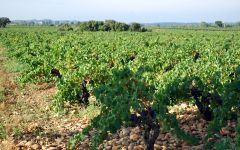Domaine Giraud Chateauneuf-du-Pape Premices 2011
-
Robert
Parker




Product Details
Your Rating
Somm Note
Winemaker Notes
Professional Ratings
-
Robert Parker's Wine Advocate
From the estate’s younger vines in Chateauneuf du Pape (around 50 year-old vines) and a new cuvee, the 2011 Chateauneuf du Pape Premices is a blend of 100% Grenache that’s aged one-third in 225-liter French oak barrels and the balance in concrete tank for one year. Gorgeous all around and made in a friendly, seamless style that’s hard to resist, it possesses a translucent ruby color that’s followed by a perfumed array of kirsch, raspberry, flowers, and red licorice. Incredibly pure and smooth, with no hard edges and a silk-like texture, it stays light and elegant on the palate and is a joy to drink.
Other Vintages
2015-
Wine
Spectator -
Robert
Parker
-
Wine
Spectator
-
Wine
Spectator





In 1998, Pierre was ready to pass on his love of the vine and wine to his children. Marie and François took on the estate hand-in-hand. Under their parents’ watchful eye, they devoted themselves to tending vines and winemaking. They focused their efforts on selecting parcel by parcel, doing minimal treatments, upgrading their cellar to make finer and finer wines while respecting family traditions. François tries hard to tend each parcel and variety respecting the "terroir" as much as possible, that alchemy nature provides us with, to fully express our grapes' full character.

With bold fruit flavors and accents of sweet spice, Grenache, Syrah and Mourvèdre form the base of the classic Rhône Red Blend, while Carignan, Cinsault and Counoise often come in to play. Though they originated from France’s southern Rhône Valley, with some creative interpretation, Rhône blends have also become popular in other countries. Somm Secret—Putting their own local spin on the Rhône Red Blend, those from Priorat often include Merlot and Cabernet Sauvignon. In California, it is not uncommon to see Petite Sirah make an appearance.

Famous for its full-bodied, seductive and spicy reds with flavor and aroma characteristics reminiscent of black cherry, baked raspberry, garrigue, olive tapenade, lavender and baking spice, Châteauneuf-du-Pape is the leading sub-appellation of the southern Rhône River Valley. Large pebbles resembling river rocks, called "galets" in French, dominate most of the terrain. The stones hold heat and reflect it back up to the low-lying gobelet-trained vines. Though the galets are typical, they are not prominent in every vineyard. Chateau Rayas is the most obvious deviation with very sandy soil.
According to law, eighteen grape varieties are allowed in Châteauneuf-du-Pape and most wines are blends of some mix of these. For reds, Grenache is the star player with Mourvedre and Syrah coming typically second. Others used include Cinsault, Counoise and occasionally Muscardin, Vaccarèse, Picquepoul Noir and Terret Noir.
Only about 6-7% of wine from Châteauneuf-du-Pape is white wine. Blends and single-varietal bottlings are typically based on the soft and floral Grenache Blanc but Clairette, Bourboulenc and Roussanne are grown with some significance.
The wine of Chateauneuf-du-Pape takes its name from the relocation of the papal court to Avignon. The lore says that after moving in 1309, Pope Clément V (after whom Chateau Pape-Clément in Pessac-Léognan is named) ordered that vines were planted. But it was actually his successor, John XXII, who established the vineyards. The name however, Chateauneuf-du-Pape, translated as "the pope's new castle," didn’t really stick until the 19th century.
